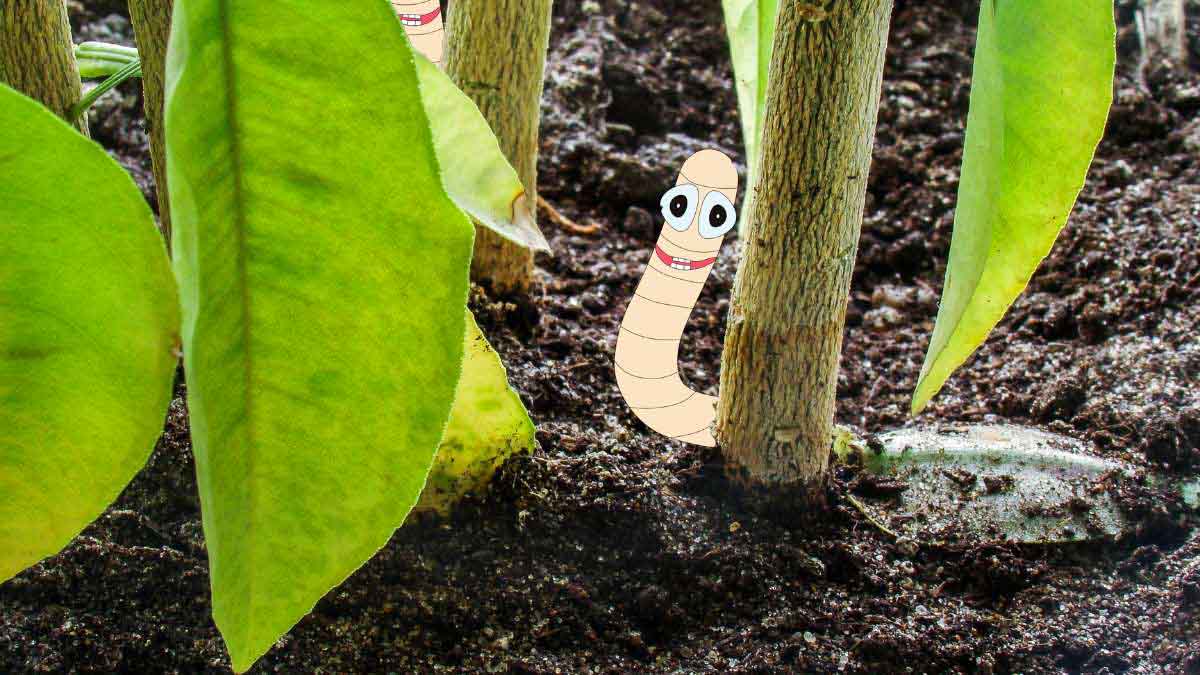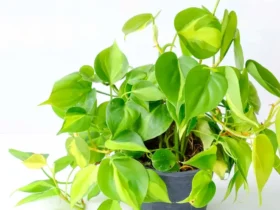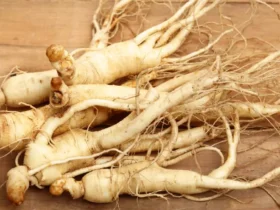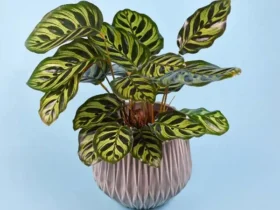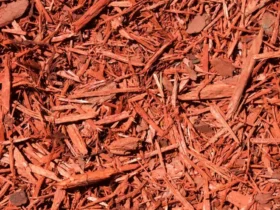Types Worm Species in Potted Plants can be classified into three main types: earthworms, potworms, and root-knot nematodes. Having worms in your potted plants can be both beneficial and harmful depending on the type of worms present and their numbers.
Earthworms, for example, can improve soil quality by aerating it and breaking down organic matter. Potworms, on the other hand, are harmless and feed on decaying plant material, but their presence can be an indicator of overwatering or poor drainage.
Root-knot nematodes, however, can cause significant damage to plant roots and impede their growth. We will explore the different types of worms commonly found in potted plants, their characteristics, and their potential effects on plant health. We will also provide tips on how to manage worm populations in your potted plants and maintain optimal plant growth.
Importance Of Potted Plants
Potted plants play a vital role in our homes, adding beauty and enhancing indoor air quality. However, they can attract various types of worms that may harm the plants’ health. It is important to understand and address the different types of worms in potted plants to maintain their well-being.
| The Importance of Potted Plants | ||
| Aesthetic Appeal | Air Purification | Stress Reduction |
| Having potted plants in your home or office can greatly contribute to the overall aesthetic appeal of the space. The vibrant colors and varying shapes of plants can instantly bring life and beauty to any room. Whether it’s a small succulent on a windowsill or a large, leafy green plant in a corner, the presence of plants can enhance the visual appeal of the surroundings and create a soothing and inviting atmosphere. | Not only do potted plants add beauty to the environment, but they also play a vital role in purifying the air. Plants are natural air purifiers as they absorb carbon dioxide and release oxygen through the process of photosynthesis. This helps in improving the air quality and reducing the presence of pollutants and toxins. By incorporating potted plants into your indoor spaces, you can create a healthier and fresher atmosphere for yourself and others. | Life can be stressful, but the presence of potted plants can help alleviate some of that stress. Research has shown that being around plants can have a calming effect on our mind and body. The green color of plants is known to have a soothing effect and can promote feelings of relaxation and serenity. Additionally, caring for plants can serve as a form of therapy and mindfulness practice, allowing you to unwind and find peace in the simple act of nurturing and tending to your potted plants. |
| Having potted plants in your home or office not only adds aesthetic appeal, but also offers numerous other benefits such as air purification and stress reduction. By incorporating plants into your indoor spaces, you can create a visually pleasing environment while also improving the quality of the air you breathe and promoting emotional well-being. Investing in potted plants is an easy and effective way to enhance the overall ambiance and create a healthier, more relaxing space. | ||
Types Of Worms Found In Potted Plants
Potted plants can be home to various types of worms, including pot worms, earthworms, and nematodes. These worms play a role in the soil ecosystem, aiding in nutrient recycling and soil aeration. Regular inspection and appropriate management are necessary to prevent any potential damage to the plants.
Earthworms
One of the most commonly found types of worms in potted plants are earthworms. These slimy creatures play a crucial role in maintaining the health of your plants. Earthworms help to aerate the soil, allowing for better water drainage and root growth. They also help in the decomposition of organic matter, providing essential nutrients to your plants. Earthworms are typically light brown or reddish in color and can vary in length.
Potworms
Potworms are another type of worm commonly found in potted plants. These small, white worms are often mistaken for pests, but they are actually harmless to plants. Potworms are indicative of a healthy growing environment as they feed on decaying organic matter in the soil. They help in breaking down organic matter into smaller particles, making essential nutrients more accessible to plant roots. If you notice potworms in your potted plants, there’s no need to worry as they are beneficial organisms.
Red Wigglers
Red wigglers, also known as red composting worms, are another type of worm commonly found in potted plants. These worms are popular for their ability to quickly break down organic materials into nutrient-rich compost. Red wigglers have a bright red color and are smaller in size compared to earthworms. Their voracious appetite for organic matter makes them excellent composting worms. Adding red wigglers to your potted plants can improve soil fertility and promote healthier plant growth.
Characteristics And Behaviors Of Earthworms

Earthworms, often referred to as nature’s plow, are beneficial creatures that play a vital role in the health of potted plants. They possess various physical characteristics that enable them to thrive in soil environments, contribute to soil health, and undergo fascinating reproductive and lifecycle processes.
Physical Characteristics
Earthworms are slim, elongated creatures with a cylindrical body. They typically range in size from a few centimeters to several inches in length. These remarkable worms are distinguished by their segmented bodies, which consist of numerous rings called segments. Each segment contains tiny bristles known as setae that aid in movement.
Role In Soil Health
Earthworms play a crucial role in maintaining soil health. Through their burrowing activities, they create tunnels that provide aeration and improve soil structure. As they move through the soil, they consume organic matter such as dead leaves and decaying plant material. These organic materials pass through the digestive tract of the worm, where they are broken down and enriched with beneficial microorganisms.
This process, known as vermicomposting, results in the production of nutrient-rich castings, also known as worm castings or vermicompost. These castings are incredibly valuable for potted plants as they increase nutrient availability, improve water retention, and enhance overall soil fertility.
Reproduction And Lifecycle
Earthworms have a fascinating reproductive and lifecycle process. They are hermaphrodites, meaning each individual possesses both male and female reproductive organs. During reproduction, two worms join together in a process called mating. They align their bodies in opposite directions and exchange sperm, which is stored for later use.
After mating, each worm forms a protective cocoon, known as an egg capsule, in which fertilization takes place. These capsules are often found within the soil. Once the eggs inside the capsule develop, tiny, immature worms known as juveniles emerge. Over time, these juveniles grow and develop into mature earthworms, thus continuing the life cycle.
It is worth noting that earthworm reproduction and development can vary depending on environmental conditions such as temperature, moisture levels, and food availability.
| Physical Characteristics | Role in Soil Health | Reproduction and Lifecycle |
| Slim, elongated body with segmented rings and setae on each segment. | Enhances soil structure, provides aeration, and produces nutrient-rich castings through vermicomposting. | Hermaphrodites with mating, egg capsule formation, and emergence of juveniles. |
To summarize, earthworms exhibit unique physical characteristics, contribute to soil health through their burrowing and vermicomposting activities, and undergo fascinating reproductive and lifecycle processes. Their presence is a boon for potted plants, ensuring optimal soil conditions and nutrient availability for healthy growth.
Potworms – Tiny Warriors Of The Soil

Hello friends, today we will be delving into the fascinating world of potted plants and the types of worms that can be found in them. In this blog post, we will be focusing on one particular group of worms known as potworms. Often overlooked because of their small size, potworms have an important role to play in our soil. They are tiny warriors tirelessly working to improve the health and fertility of our potted plants. Let’s learn more about these unsung heroes!
Identification
Potworms, scientifically known as enchytraeids, are tiny worms that can measure only a few millimeters in length. These thread-like creatures have a translucent appearance, making them difficult to spot without close inspection. Due to their small size and pale color, they are often mistaken for white worms or other pests. However, potworms can be easily distinguished by their unique pointed heads and segmented bodies. They have a slight curl, which allows them to move through the soil with ease.
Habitat And Feeding Habits
Potworms are most commonly found in moist, organic-rich soil, which makes potted plants an ideal habitat for them. They thrive in the top layers of the soil, where organic matter is abundant. These hardworking worms feed on decaying plant material, fungi, bacteria, and other organic matter present in the soil. As they devour organic matter, they break it down into smaller particles, aiding in the decomposition process. This helps to release nutrients trapped in dead plant material, making them more readily available to the potted plants.
Potworms are also voracious decomposers, rapidly consuming fungal spores and other organisms that can potentially harm the plants. They act as a natural defense mechanism against soil-borne diseases and pests, making them true warriors of the soil. Their constant movement and feeding habits also help to aerate the soil, improving its overall structure and allowing roots to absorb water and nutrients more efficiently.
Benefits And Drawbacks
The presence of potworms in your potted plants has several benefits. Firstly, these tiny worms enhance the soil’s fertility by breaking down organic matter and releasing valuable nutrients. This can result in healthier and more vigorous plant growth. Their feeding habits also contribute to the suppression of harmful pests and diseases, promoting a healthier overall ecosystem for your potted plants. In addition, their constant movement through the soil helps to improve its structure and drainage.
However, it is important to note that large populations of potworms can sometimes be an indication of excessive moisture or overfeeding. While having a few potworms in your potted plants is generally beneficial, an overwhelming population can lead to soil compaction and an imbalance in the ecosystem. It is essential to monitor their numbers and adjust watering and feeding frequency accordingly.
In conclusion, potworms may be small in size, but their impact on the health of potted plants is remarkable. These tiny warriors work tirelessly to improve soil fertility, protect against pests and diseases, and aerate the soil. By understanding their identification, habitat, feeding habits, and the benefits they bring, we can better appreciate their contribution to our potted plants’ well-being.
Red Wigglers – Silent Composters

Red wigglers, a type of worm commonly found in potted plants, are efficient composters without making any noise. They break down organic materials, transforming them into nutrient-rich compost for healthier plants.
Distinctive Features
Red Wigglers, also known as Eisenia fetida, are fascinating creatures that play a crucial role in composting. These worms have distinct features that set them apart from other worm species. Their reddish-brown color and slender bodies make them easily recognizable. Moreover, they have a segmented body structure with a ring-like appearance. Red Wigglers can grow up to 3 inches long and are known for their exceptional reproductive capabilities. With no lungs or vocal cords, these silent composters silently get to work breaking down organic materials in potted plants.
Composting Prowess
Red Wigglers are highly efficient when it comes to composting. They consume and break down organic matter such as food scraps, leaves, and paper into nutrient-rich compost. One adult worm can devour up to half its body weight in a day, making them veritable composting powerhouses. They have a voracious appetite for decaying materials and microorganisms, speeding up the composting process significantly. As they digest the organic matter, the worms excrete castings, which are valued as a superior organic fertilizer. These castings, also known as vermicast, enrich the soil by improving its structure and nutrient content.
Tips For Successful Vermicomposting
To ensure successful vermicomposting with Red Wigglers, here are some useful tips:
- Choose the right container: Use a suitable container with drainage holes and a lid to create a conducive environment for the worms.
- Provide bedding: Add moist bedding materials such as shredded newspaper, coconut coir, or straw to create a cozy home for the worms.
- Feed them properly: Offer a balanced diet of fruit and vegetable scraps, coffee grounds, tea leaves, and crushed eggshells. Avoid feeding them meat, dairy, oily or acidic foods.
- Maintain moisture: Keep the bedding moist but not overly wet. Red Wigglers require a damp environment to thrive.
- Avoid overcrowding: Start with a sufficient number of worms based on the amount of waste you generate. As they multiply, adjust the worm population accordingly.
- Aerate the bin: Occasionally turn the bedding to increase oxygen levels in the compost pile and prevent unpleasant odors.
- Harvest the castings: Periodically harvest the vermicast from the bin to use it as fertilizer in your potted plants.
- Monitor the system: Regularly observe the worm bin for any issues such as pests or an imbalance in the composting process.
By following these tips, you can utilize the composting prowess of Red Wigglers to create nutrient-rich soil amendments for your potted plants. Happy vermicomposting!
Relationship Between Worms And Potted Plants
The relationship between worms and potted plants goes beyond what meets the eye. These slimy creatures may not seem like the most glamorous addition to your indoor garden, but they play a vital role in creating a healthy and thriving environment for your plants. From enhancing soil structure and aeration to providing nutrient-rich castings, worms are nature’s underground superheroes when it comes to plant growth and sustainability.
Enhanced Soil Structure And Aeration
Worms are like tiny tillers of the soil, silently working beneath the surface to improve the structure and aeration of the potting mix. As they move through the soil, their burrowing creates tunnels and channels, allowing air, water, and plant roots to penetrate deeper. This enhanced soil structure promotes better drainage, prevents compaction, and enables the roots to access essential nutrients.
In addition to creating pathways, worms also help break down organic matter, such as dead leaves and plant debris. This decomposition process further nourishes the soil, making it more fertile and conducive to plant growth.
Nutrient-rich Castings
One of the most valuable contributions that worms make to potted plants is their production of nutrient-rich castings, commonly known as worm castings or vermicompost. These castings are the result of the worms digesting the organic matter present in the soil and breaking it down into a highly fertile form.
Worm castings are packed with essential nutrients, including nitrogen, phosphorus, potassium, calcium, and trace minerals. When these castings are incorporated into the potting mix or applied as a top dressing, they slowly release these nutrients over time, providing a steady and balanced supply to the plants. This natural fertilizer promotes robust growth, improves plant immunity, and enhances overall plant health.
Prevention Of Plant Diseases
Another significant advantage of having worms in potted plants is their ability to prevent and combat plant diseases. When worms consume organic matter, they also ingest harmful pathogens and bacteria present in the soil. These pathogens then pass through the worm’s digestive system, where they undergo decomposition and neutralization.
The castings produced by worms possess beneficial microbes and enzymes that suppress the growth of harmful pathogens, such as fungi and bacteria. This natural probiotic effect acts as a protective shield for plants, reducing the risk of infections, root diseases, and other plant ailments.
The presence of worms in the potting mix balances the soil ecosystem, creating an environment that is unfavorable for diseases to thrive. This preventive measure not only promotes plant health but also reduces the need for chemical pesticides and fungicides, making your indoor garden more sustainable and eco-friendly.
Discovering Worms In Your Potted Plants

Are you a plant enthusiast who loves having potted plants around your home? If so, you may have encountered the discovery of worms in your potted plants. While this might initially come as a surprise, it’s actually a positive sign of a healthy ecosystem within your pots. In this article, we will explore the different types of worms that commonly inhabit potted plants, as well as how to identify their presence and encourage their populations for the benefit of your plants’ overall health.
Signs Of Worm Presence
Worms play a crucial role in maintaining soil health by aiding in the decomposition of organic matter and enriching the soil with their castings. Fortunately, there are a few signs to look out for when it comes to worm presence in your potted plants. Some of these signs include:
- Burrows or tunnels in the soil
- Presence of worm castings on the soil surface
- Increase in plant growth and overall plant health
If you notice any of these signs, it’s highly likely that you have a thriving worm population in your potted plants. These beneficial creatures are working hard to create a nutrient-rich environment for your plants to thrive.
Digging For Worms
If you’re curious about the types of worms present in your potted plants, you can embark on a mini treasure hunt by gently digging into the soil. Use a small garden trowel or your hands to carefully dig and sift through the soil. You may find a variety of worms such as:
- Red Wigglers (Eisenia fetida)
- Earthworms (Lumbricus terrestris)
- Nightcrawlers (Lumbricus terrestris)
Worms can vary in size and color, but they all serve the same purpose of increasing soil fertility and improving plant health. Remember to handle them gently and return them to the soil afterward so they can continue their beneficial work.
Encouraging Worm Populations
To ensure a thriving worm population in your potted plants, there are a few measures you can take. Consider the following tips:
- Provide an organic and rich soil mix for your plants
- Avoid using synthetic chemical fertilizers or pesticides that may harm worms
- Regularly add organic matter, such as compost or worm castings, to replenish nutrients
- Keep the soil consistently moist, but avoid overwatering which can drown worms
- Avoid disturbing the soil excessively, allowing worms to work undisturbed
By following these practices, you can create an environment that is conducive to worm populations, ultimately leading to healthier plants and improved soil quality.
Frequently Asked Questions Of Types Worm Species In Potted Plants
What Do Potworms Look Like?
Potworms are small, worm-like creatures that are typically white in color and measure about 1-2 millimeters long. They have transparent or slightly translucent bodies with distinct segments. These tiny creatures are commonly found in organic-rich environments such as compost piles or potting soil.
What Kind Of Worms Live In Potting Soil?
Potting soil is inhabited by various types of worms, including earthworms, red wigglers, and nematodes. These worms play a vital role in maintaining soil health and promoting plant growth.
Are Worms Good For Potted Plants?
Worms are great for potted plants as they help improve the soil quality and promote better drainage. They enhance nutrient levels, prevent soil compaction, and enhance root growth. Their burrowing also increases oxygen in the soil, fostering a healthier environment for plant growth.
How Do You Get Rid Of Worms In Plants?
To get rid of worms in plants, use natural methods like neem oil or homemade insecticidal soap. You can also handpick the worms and drop them in soapy water. Implementing proper sanitation practices and regularly inspecting your plants can prevent further infestations.
Conclusion
Understanding the different types of worms that can affect potted plants is crucial for their overall health and well-being. From root-knot nematodes to fungus gnat larvae, each worm has unique characteristics and potential effects on plant health. By being aware of these pests, gardeners can take proactive measures to prevent and treat infestations, ensuring their potted plants thrive.
So, next time you spot any unusual symptoms or signs of worm activity, take action promptly to protect your cherished plants.
